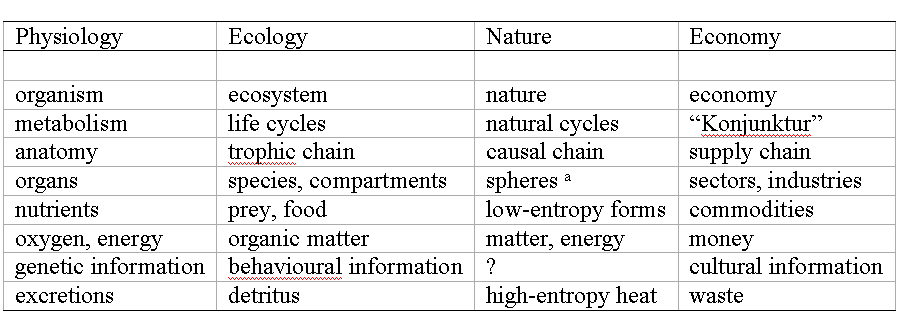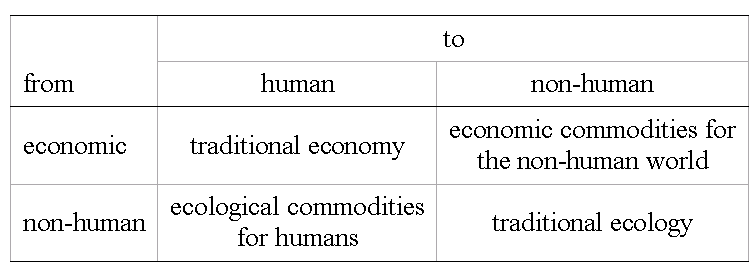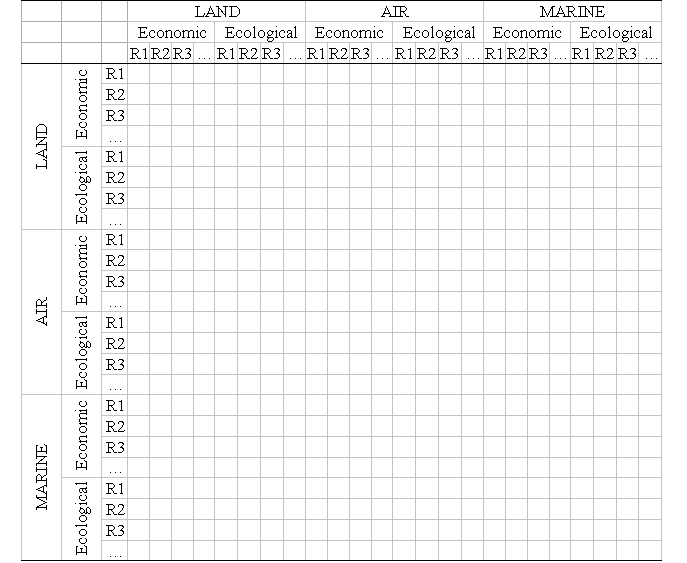 |
Integrated Sustainability Analysis |
 |
| Home Contact Search Media |
Ecological SystemsThe recognition that both ecology and economics are grounded in common biophysical foundations has a long tradition. This biophysical foundation is represented by the continual interplay of sunlight, photosynthesis, chemical energy, air, soil, water, and organic matter. Traditionally, both ecology and economics address only non-human and human interdependencies, respectively. Consequently, environmental problems arising out of industrial pollution have been termed �externalities� by economists, even though they are quite internal to the world we depend on. An excellent quote in this respect is probably that of biologist Marston Bates given by Daly (1968): �Then we come to man and his place in the system of life. We could have left man out, playing the ecological game of �let�s pretend man doesn�t exist�. But this seems as unfair as the corresponding game of the economists, �let�s pretend that nature doesn�t exist�. The economy of nature and ecology of man are inseparable and attempts to separate them are more than misleading, they are dangerous. Man�s destiny is tied to nature�s destiny and the arrogance of the engineering mind does not change this. Man may be a very peculiar animal, but he is still a part of the system of nature.� Daly also cites work by Alfred Marshall and other authors dating back to the 1920s that contains references to ecological analogies in economics. As of the former, comparisons have been made at varying scales, ranging from individuals, via living ecosystems to animate and inanimate nature (Tab. 1). Tab. 1: Analogous terms and concepts in physiology/ecology and economics. Notes: a atmosphere, hydrosphere, lithosphere, etc. A number of authors focus on the common feature of organisms and consumers maintaining a thermodynamic disequilibrium (life), or distance from equilibrium (death), by exchanging high-entropy outputs for low-entropy inputs, amongst them Georgescu-Roegen (1971; 1976). This author deplores economists ignoring their environment by assuming the economic process to be �completely circular and self-sustaining�, whereas in reality (according to the Second Law of Thermodynamics) economies are open systems that need to feed on valuable low-entropy resources from their environment (nature, the sun), but irreversibly transform this into valueless high-entropy waste (disorder, heat), thus maintaining constant own entropy throughout at the cost of increasing the entropy of the entire system they are part of. Georgescu-Roegen (1976, pp. 58-59) distinguishes two low-entropy sources: relatively scarce fossil fuels and relatively abundant solar radiation, and recommends, in view of humanity currently depending on the scarcer source, to shift attention towards the more abundant solar energy. Since in principle neither the earth nor the solar system is thermodynamically closed, an overall (constant-entropy) steady state can be reached neither relying on fossil fuels nor on solar energy, but the more solar energy is used, the lower the rate of terrestrial entropy increase. The first author to suggest a quantitative input-output-type framework to describe the structure of ecosystems was Hannon (1973), who drew on previous experiences in industrial energy analysis (Hannon 1972; Folk and Hannon 1973) to define production and respiration energy flows between individuals, species or trophic levels, or in general, compartments. Hannon defines system measures such as production and respiration flows, inflows and outflows, and total system throughflow. Finn (1976) and Patten et al. (1976) define further measures of ecosystem structure. The outflow path length, and the inflow path length measure the average number of compartments through which outflow has passed, and through which inflow will pass. The first suggestion for a combining a compartmental model of the environmental impact of industries with an economic input-output model was made by Cumberland (1966). While this author merely drew attention to the possibility of extending the traditional accounting framework, Isard et al. (1967) and Daly (1968) added mathematical rigour to the formulation, and went even further in that they proposed a module containing interactions within the ecological system in addition to flows between the environment and the economy. Of this work, only Isard and Langford (1971; Isard et al. 1972) have attempted to apply the concept to the real world, using comprehensive regional data. Like Isard and Daly, Ayres and Kneese (1969) recognise the fundamental importance of the material balance principle in formulating an ecological-economic framework. These authors extend Walras� general equilibrium model to mass flows in and out of the environment. A review and critique of these early models is provided by Victor (1972, pp. 25-52). Dealing with reconciling �ecological� inputs and outputs of the economic system and the condition of material balance, researchers encountered the problem of incommensurability of flows because of their different physical units. This proved to be an obstacle for analytical operations, which was overcome by Leontief and Ford (1970). Early input-output models, such as by Daly (1968) and Isard et al. (1967), incorporated pollution as outputs of industries, assembled in additional columns of the interindustry table, leading to incompatible units and summation problems across rows (see Forssell and Polenske, 1998, p. 92). The solution of Leontief and Ford (1970) to reverse the position of environmental inputs and outputs (ie to assemble generated pollutants as inputs in rows) made this type of model operational. Daly (1968) gives an input-output representation of a holistic, integrated ecological-economic model (Tab. 2). It shows the purely economic and ecological interactions as well as ecosystem commodities linked to the economy (for example resources, pollution12 etc) and economic commodities linked to the ecosystem (for example economic activity directed towards environmental protection, waste assimilation etc). Tab. 2: Simple input-output representation of ecology-economy interdependencies (after Daly 1968, p. 401). At the same time, Isard and coworkers went to great lengths in drawing up detailed multi-regional ecologically-extended input-output frameworks (Tab. 3), adding to the economic commodities surveyed ecological data such as on winter flounder and water use (Isard et al. 1967), cod and phytoplankton (Isard 1969; Isard and Langford 1971), clam/mussel production and the phosphorus cycle (Isard et al. 1972, Ch. 4). The authors demonstrate potential uses of their framework using case studies of developments of a new town with beach facilities (Isard et al. 1967) and a marina (Isard et al. 1972, Ch. 5). Tab. 3: Isard�s representation of ecology-economy interdependencies (after Isard 1969; Isard and Langford 1971). R = Region. Since Isard's pioneering work, the crucial question has been whether the non-human, ecological quadrants in Tabs. 2 and 3 can be determined with sufficient accuracy and detail in order to provide a useful decision-making tool. While a limited range of non-human indicators have been incorporated into economic analysis, uncovering natural interdependencies has been anything but successful. It is often asserted that not valuing ecosystem services and natural capital adequately (see Costanza et al. 1998) � in other words the ignorance of the environment in economics � has lead to resource depletion, ecosystem overexploitation, and pollution that humanity is faced with today. While this ignorance was possibly nurtured by the unprecedented achievements made during the industrial revolution of the 19 For further information contact us for the journal article
For further reading :
For further information please contact
|


